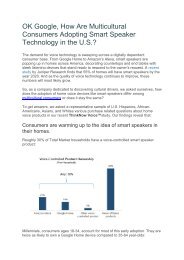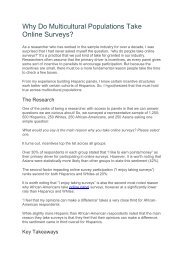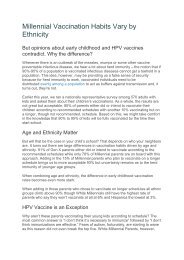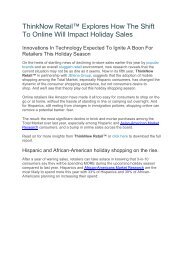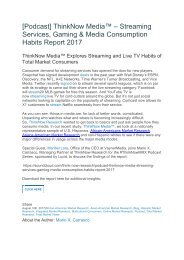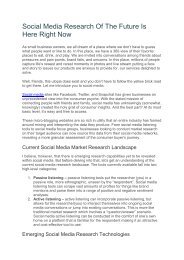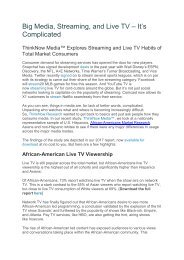Why Are Hispanic Millennials Streaming More Spanish-language Content
It’s no secret that traditional Spanish broadcast networks have been experiencing a steady loss of viewers in the U.S. year over year. Many factors are contributing to this decline including a slowing in immigration from Mexico. But, perhaps even more impactful is the fact that growth in the U.S. Hispanic market is primarily coming from U.S. born. However, our latest report, which focuses on the media habits of the Total Market, shows a significant increase in the number of Hispanic millennials streaming Spanish language content via OTT (over the top) services.
It’s no secret that traditional Spanish broadcast networks have been experiencing a steady loss of viewers in the U.S. year over year. Many factors are contributing to this decline including a slowing in immigration from Mexico. But, perhaps even more impactful is the fact that growth in the U.S. Hispanic market is primarily coming from U.S. born. However, our latest report, which focuses on the media habits of the Total Market, shows a significant increase in the number of Hispanic millennials streaming Spanish language content via OTT (over the top) services.
Create successful ePaper yourself
Turn your PDF publications into a flip-book with our unique Google optimized e-Paper software.
<strong>Why</strong> <strong>Are</strong> <strong>Hispanic</strong> <strong>Millennials</strong> <strong>Streaming</strong><br />
<strong>More</strong> <strong>Spanish</strong>-<strong>language</strong> <strong>Content</strong>?<br />
It’s no secret that traditional <strong>Spanish</strong> broadcast networks have been experiencing a<br />
steady loss of viewers in the U.S. year over year. Many factors are contributing to<br />
this decline including a slowing in immigration from Mexico. But, perhaps even more<br />
impactful is the fact that growth in the U.S. <strong>Hispanic</strong> market research is primarily<br />
coming from U.S. born. However, our latest report, which focuses on the media<br />
habits of the Total Market, shows a significant increase in the number of <strong>Hispanic</strong><br />
millennials streaming <strong>Spanish</strong> <strong>language</strong> content via OTT (over the top) services.<br />
We asked a representative sample of U.S. <strong>Hispanic</strong>s the following question in Q2 of<br />
2017 and compared it with the same question we asked of a representative sample<br />
of U.S. <strong>Hispanic</strong>s in 2015 through our <strong>Hispanic</strong> Millennial Project:<br />
Have you streamed any <strong>Spanish</strong>-<strong>language</strong> programming in the past 30 days?<br />
Among <strong>Hispanic</strong>s ages 35-64, there was a minimal lift in <strong>Spanish</strong>-<strong>language</strong><br />
streaming from 2015 to 2017:<br />
In 2015, 41% of <strong>Hispanic</strong>s 35-64 reported streaming <strong>Spanish</strong>-<strong>language</strong> content vs.<br />
47% in 2017. While this represents a six-point shift, it is not statistically significant.<br />
However, looking at the 18-34 <strong>Hispanic</strong> millennial cohort, we see a much different<br />
picture:
Among <strong>Hispanic</strong> millennials, we do see a statistically significant increase in <strong>Spanish</strong><strong>language</strong><br />
streaming from 2015 to 2017, from 46% to 65%, a staggering 19-point<br />
jump.<br />
So, what’s driving this explosion of <strong>Spanish</strong>-<strong>language</strong> streaming behavior among<br />
<strong>Hispanic</strong> millennials? Here are my thoughts:<br />
1. <strong>More</strong> Options: In August of 2015, Netflix released its first <strong>Spanish</strong>-<strong>language</strong><br />
original series, Club de Cuervos. Since then, we have seen a surge of original<br />
<strong>Spanish</strong>-<strong>language</strong> programming available on multiple streaming platforms<br />
such as Hulu, Amazon Prime, and YouTube Red. Prior to streaming options,<br />
<strong>Hispanic</strong> millennials were confined to traditional broadcast networks such as<br />
Univision and Telemundo. But with the rising popularity of streaming, these<br />
networks find themselves in the fight of their lives as they rage against a<br />
technology that makes delivering <strong>Spanish</strong>-<strong>language</strong> content to content<br />
craving millennials effortless. And we’ll see this natural progression towards<br />
streaming more <strong>Spanish</strong>-<strong>language</strong> content continue.<br />
2. Digital Reculturation: A topic I’ve written on before, digital reculturation is<br />
the process of rediscovering one’s culture of origin/identification online<br />
through digital representations of culture. Companies like mitú and Remezcla,<br />
for example, are bringing <strong>Hispanic</strong> culture (more specifically, bi-cultural<br />
<strong>Hispanic</strong> millennial culture) to the forefront of all their content, driving further<br />
exploration of <strong>Spanish</strong>-<strong>language</strong> content via streaming. Mitú, in particular, has<br />
expanded into original Netflix content, closing the gap between digital content<br />
and streaming services.<br />
3. Family: While <strong>Spanish</strong>-<strong>language</strong> proficiency is waning among U.S. <strong>Hispanic</strong>s,<br />
95% of U.S. <strong>Hispanic</strong>s say it is important that future generations of <strong>Hispanic</strong>s<br />
living in the U.S. be able to speak <strong>Spanish</strong>. As millennials have children,
many may not be proficient enough in <strong>Spanish</strong> to transfer the <strong>language</strong> to<br />
their children. <strong>Streaming</strong> <strong>Spanish</strong>-<strong>language</strong> children’s content may be the<br />
millennial version of Español sin barreras for kids. The rise in <strong>Spanish</strong><strong>language</strong><br />
content isn’t geared only towards millennials. There are now more<br />
<strong>Spanish</strong>-<strong>language</strong> children’s shows than ever available for streaming.<br />
This surge in <strong>Spanish</strong> <strong>language</strong> streaming among millennials is fascinating. The<br />
tension in data between a population that is becoming more English-dominant yet is<br />
streaming more <strong>Spanish</strong>-<strong>language</strong> content is fertile ground for researchers to<br />
cultivate a deeper understanding of this growing trend and the cohort driving it. For<br />
marketers, the data makes one thing crystal clear: <strong>Spanish</strong>-<strong>language</strong> is still relevant.<br />
The burden for marketers will be figuring out how to infuse <strong>Spanish</strong>-<strong>language</strong><br />
messaging into a population that operates in an English-dominant world.<br />
This blog post was originally published on Engage: <strong>Hispanic</strong>s<br />
Share1<br />
September 25th, 2017|Blog, <strong>Hispanic</strong> Market Research, <strong>Hispanic</strong> <strong>Millennials</strong>, <strong>Hispanic</strong> Online Research, Online<br />
Market Research, Total Market Research<br />
About the Author: Mario X. Carrasco<br />
Mario X. Carrasco is Co-Founder and Principal of ThinkNow Research, an awardwinning<br />
culturally-integrated market research agency based in Burbank, CA. The<br />
agency integrates <strong>Hispanic</strong>, African-American, and Asian insights into custom<br />
market research for companies and government agencies looking to thrive in a<br />
changing demographic environment.Under his co-leadership, ThinkNow Research<br />
has successfully launched several innovative market research initiatives, such as<br />
DigaYGane.com, one of the largest and most representative <strong>Hispanic</strong> online panels<br />
in the industry as well as the first Minority Business Owner (B2B) Panel in the U.S.




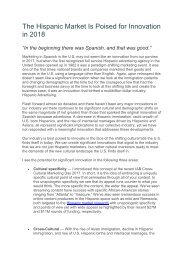
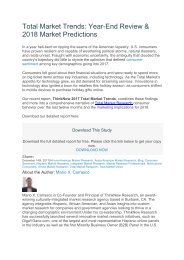
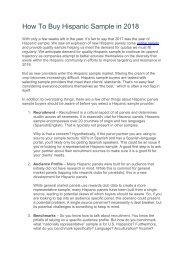


![[Podcast] ThinkNow Voice™ Total Market Smart Speaker Purchase Habits](https://img.yumpu.com/59553142/1/184x260/podcast-thinknow-voicetm-total-market-smart-speaker-purchase-habits.jpg?quality=85)
